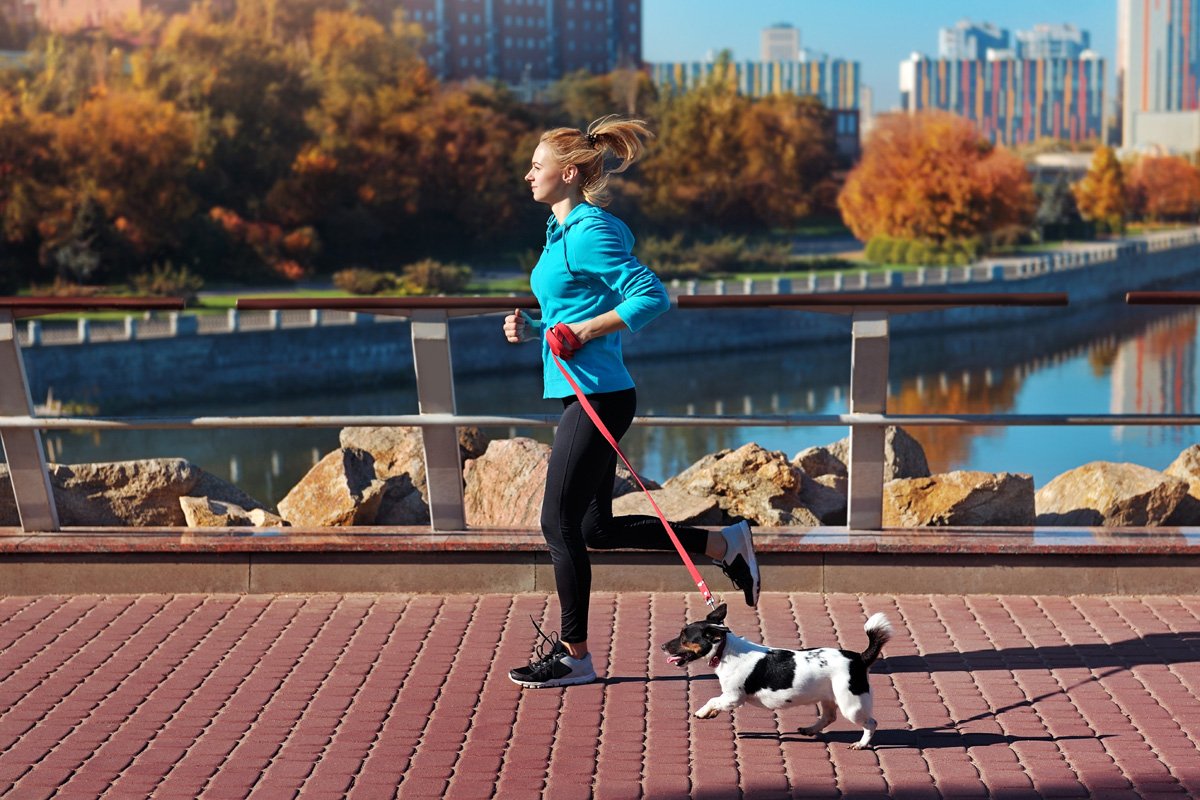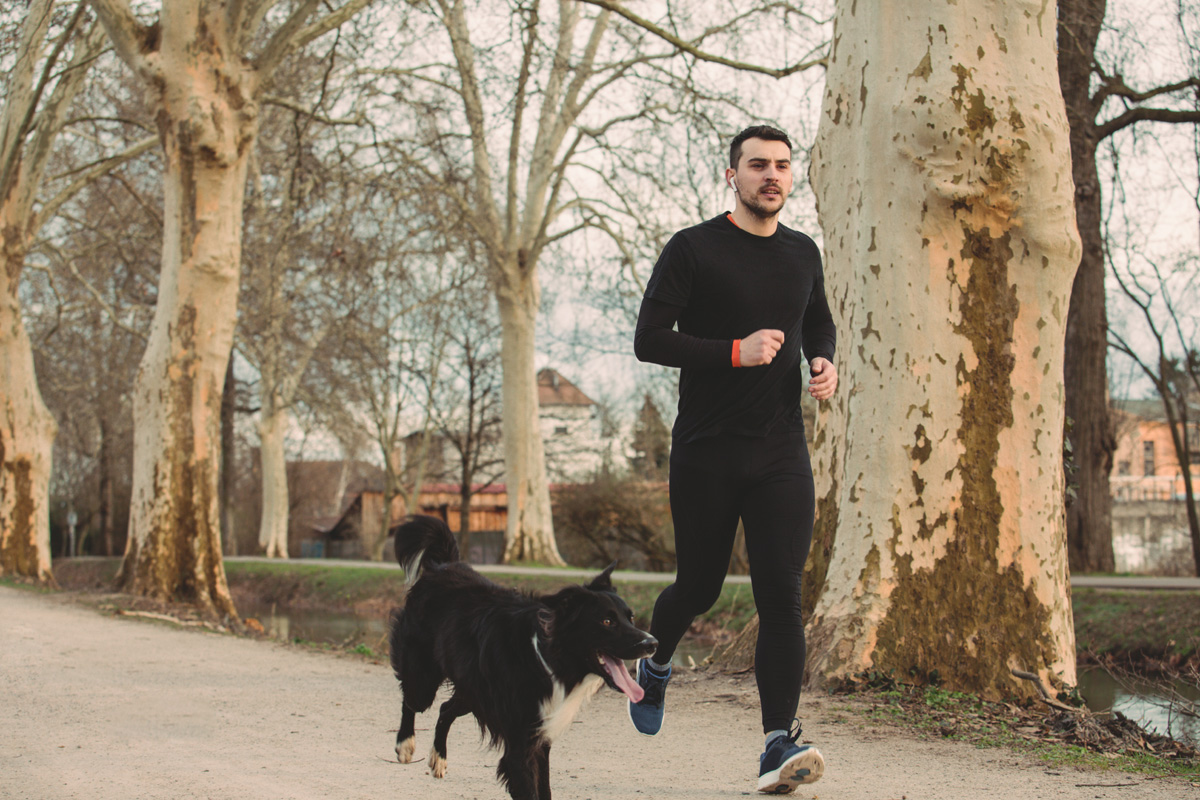People aren’t the only ones to experience a high when running. According to a 2012 study published in the Journal of Experimental Biology, dogs also feel a sense of euphoria after exercising. Before grabbing the leash to head out on a run, though, consult with your veterinarian to make sure your dog is healthy enough to join you. And as with any exercise program, you’ll need to start slowly. Following are five of the best dog breeds for runners.
Brittany
The American Kennel Club (AKC) describes the Brittany as a bright, high-energy dog bred to hunt. These dogs need lots of exercise and enjoy running with their favorite human companions.
Temperament: Brittanys are sociable, intelligent dogs who love to learn and are easy to train. This breed loves people and enjoys being included in family activities. They are prone to barking or destructive behavior if not exercised enough.
Coat care: According to American Brittany Rescue Inc., these dogs are low maintenance in terms of coat care and upkeep. Their coat needs to be brushed with a slicker brush just once or twice a week to remove dead hair and check for any health issues or parasites.

Parson Russell terrier
These dogs may be small in stature, but they are tough and full of energy. Breed experts at the AKC say these terriers are fast enough to follow foxhounds on the hunt and swift enough to run with horses. They thrive on action and adventure, making them terrific running buddies.
Temperament: Parson Russell terriers are smart and love to learn, but they get bored easily, so training sessions need to be fun. If properly socialized, these little guys can get along with well-behaved children.
Coat care: These terriers can have smooth or rough coats. Both types require regular brushing. A thick brush or hound glove can be used on the smooth coat, while a slicker brush works well on rough-coated terriers. The rough coat does require more maintenance as it needs to be plucked or clipped to avoid matting.
Weimaraner
Weimaraners are big, athletic, intelligent hunting dogs who thrive on exercise. Breed enthusiasts at the Weimaraner Club of America (WCA) say these dogs have great stamina and can work and play for long periods. They need an outlet for their energy and make excellent running partners.
Temperament: According to the WCA, most Weimaraners love the company of humans. They tend to stay close to their family members, are curious, and want to be included in family outings. They have a natural desire to please, making them easy and fun to train.
Coat care: Weimaraners have short coats, but they do shed. Brushing once a week with a bristle brush will remove dead hair and keep their coat and skin healthy.
Australian cattle dog
The Australian cattle dog was developed by Australian ranchers looking for a dog with the endurance to drive cattle over long distances. According to the Australian Cattle Dog Rescue Association, they are high-energy dogs with the stamina to make great running and hiking buddies.
Temperament: This breed does best in a home with an active family where they get lots of exercise. These dogs may not be the best choice in a family with small children because of their herding instincts. They are intelligent dogs who love to work but do need pet parents who are leaders and can provide direction using positive-motivation training.
Coat care: The Australian cattle dog has a smooth double-layer coat that is rain and dirt resistant. During shedding season in the spring and fall, they need to be brushed every few days to remove the dead hair. The rest of the year, a brushing once or twice a week will suffice.

Border collie
This intelligent, athletic breed is described by AKC experts as extremely energetic and not satisfied with just a walk around the block or a romp in the yard. They have great stamina and make wonderful workout buddies whether going for a short jog or a long-distance run.
Temperament: Training experts say that early socialization with people and other dogs is extremely important to avoid behavioral problems with border collies. They are highly trainable, and the AKC calls them superstars in the world of canine sports.
Coat care: Border collies can have either a rough coat that is medium length and feathered or a smooth coat that’s shorter and coarser. Grooming for both coat types includes brushing once or twice a week to avoid mats and tangles. Daily brushing to remove dead hair will be needed during the fall and spring shedding seasons.
Whichever breed you choose, it’s important to take precautions to prevent injury to your dog. Veterinary experts at the American Veterinary Medical Association (AVMA) say it’s important for runners to bear in mind that while their feet are protected by cushioned athletic shoes, their four-legged buddies are working out barefoot. That’s not generally a problem when running on grass or other natural surfaces, but running on concrete, asphalt, or gravel can put a lot of stress on your dog’s body. It can also put them at risk of injury to their legs, paws, or paw pads. The AVMA offers a great list of rules to follow to keep your pet safe while running. With the proper precautions, you and your dog can enjoy many hours of running in the great outdoors.
Editors' Recommendations
- Are ‘dog years’ really 7 human years? How to calculate your dog’s age
- Is your dog barking nonstop? Here’s how to get your noisy pup under control
- When can kittens leave their mom? Don’t separate them too early
- When do kittens’ eyes change colors? The answer is so cool – here’s what to know
- A simple guide to what to feed tadpoles in your aquarium




